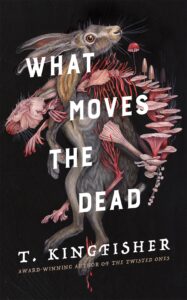 What Moves the Dead by T. Kingfisher
What Moves the Dead by T. Kingfisher Series: Sworn Soldier #1
Genres: Adult, Fiction, Gothic, Horror, Psychological Horror, Retelling, Speculative Fiction, Suspense, Thriller
Published by Tor Nightfire on July 12, 2022
Format: Hardcover
Pages: 165

From the award-winning author of The Twisted Ones comes a gripping and atmospheric retelling of Edgar Allan Poe's classic "The Fall of the House of Usher."
When Alex Easton, a retired soldier, receives word that their childhood friend Madeline Usher is dying, they race to the ancestral home of the Ushers in the remote countryside of Ruravia.
What they find there is a nightmare of fungal growths and possessed wildlife, surrounding a dark, pulsing lake. Madeline sleepwalks and speaks in strange voices at night, and her brother Roderick is consumed with a mysterious malady of the nerves.
Aided by a redoubtable British mycologist and a baffled American doctor, Alex must unravel the secret of the House of Usher before it consumes them all.
Foreboding and just slightly unsettling, T. Kingfisher’s What Moves The Dead is an atmospheric modern retelling of Edgar Allen Poe’s famous short story The Fall of the House of Usher. If one is familiar with the literary classic source material, you can roughly follow and know what to expect in this short novella. However, unlike the original short story, T. Kingfisher expands the classic tale with some clever ideas and twists that help this interpretation successfully stand out on its own. Additionally, added character motives, speculative fiction elements, and a bit of fringe science importantly attempt to address the source materials formulaic shortcomings and common criticisms, resulting in a solidly accomplished read that is accessible and not too spooky/disturbing for most readers.
Clocking in at around 160 pages, What Moves the Dead is an easy to read novella that’s self-contained and straightforward. However unlike the original story that leaves a lot open to interpretation, T. Kingfisher attempts to fill-in and answer a lot of the unknown factors that Poe never explicitly addressed. A common point of criticism about most horror mansion/estate tales is questioning why the narrator doesn’t leave once they begin to encounter unsettling experiences. She addresses this by directly having the narrator Alex Easton summoned by Roderick Usher via a letter and greatly expanding their friendship and backstories with their time serving during wartime. In Poe’s story, the motive behind Roderick’s actions as well as Madeline’s increased presence and visual depictions make the novella feel like a more well-rounded and complete story vs the original’s focus on the claustrophobic and imposing atmosphere. Unlike the original’s more supernatural elements, this version uses a more speculative science approach that aligns with late 19th century discoveries which I personally found interesting and quite effective, though I am far from a traditionalist who may find this interpretation deviates too liberally from the source material. Without giving away any spoilers, I was pleasantly surprised by the direction Kingfisher went with this novella and was impressed with how she was able to repurpose a lot of the original story’s key scenes and expand the scope of the story (though I do miss the iconic House of Usher “split” that obviously is hard to realistically portray outside of the fantasy genre).
My only small nitpick is that while this book was a page-turner for me from the 100 page mark onward, I found the read to be a bit slow after its opening two chapters. Apart from the introductions of both Poe’s original characters as well as Kingfisher’s additions, the first half of the book felt like the story veered off-course, heavily focusing on Alex’s history in Gallacia and self-referencing this country repeatedly (I spent way too long trying to figure out if Kingfisher’s Gallacia is one either of the real-world Galicia entities to no avail). While I liked the modern representation, exploration of Alex’s non-binary identity (obviously not referred to as such given the time period this is set in) and the world-building detailed added to flesh out the Narrator’s character, I couldn’t help but feel like the focus and details were unnecessary and mostly irrelevant to the main story that disrupted the otherwise consistent pacing. It feels ironic to say considering the book is already so short, but at times the first half felt like the story was being padded out longer than it needed to be. Upon finishing the book, the excessive focus about Gallacia and Alex’s sworn soldier status felt like a heavy-handed approach to setting up what is now a series, and unnecessarily forcing details for future books into this one.
Despite some minor reservations, I thought What Moves the Dead was a solid and well-written short novella that is successful both as a modern retelling of a literary classic as well as a standalone reading experience (no knowledge of the source material is needed, though it is fun to see how the source material was utilized and reworked). Although the tone, sentence structure and vocabulary give the book its clear historic time and place, Kingfisher’s prose is still highly-accessible for contemporary readers while adding just the right amount of flavor. The fact that this book also isn’t too spooky or disturbing (relatively low graphic depictions apart from a brief dissection of a dead animal and mild body horror) also makes it an easy recommendation for readers looking for a horror book that’s not too intense. Also completely unrelated to the story, I thought the book’s cover, jacket art, design and endpaper art were beautiful and perfectly match the book’s contents and vibe (if you see the book in person or on a large resolution, it’s a rabbit laying on top of mushrooms and fungi rather than what I thought was a skeleton and exposed flesh, this book is not gory at all). This was one I was very thankful to be able to read in a printed hardcover edition rather than an ebook copy.
